Listen:
Scroll down for a transcript, video, how to subscribe, and more
Notes:
Welcome to Episode #58 of Habitual Excellence, presented by Value Capture.
 In today's episode, our guests are John B. Anderson, Jr., MD, MPH, the Chief Medical Officer for Duke Primary Care, part of the Duke University Health System, and Elizabeth Long, their Chief Operating Officer.
In today's episode, our guests are John B. Anderson, Jr., MD, MPH, the Chief Medical Officer for Duke Primary Care, part of the Duke University Health System, and Elizabeth Long, their Chief Operating Officer.
In the episode, Liz and John discuss an overarching theme of Transforming Primary Care -- through Lean management practices and continuous improvement, with our host, Mark Graban. Topics and questions include:
- Liz and John's professional backgrounds
- Tell us about your organization’s Improvement journey — how they started and why?
- What is the focus on improvement in primary care?
- Teamwork and collaboration across sites? More broadly? How to encourage this?
- Why did your focus shift to a management system?
- Creating the culture of quality and continuous improvement
- A3 problem solving - as a method for continuous improvement?
- Morning huddles, tiered huddles?
- Benefits & results?
- Lessons learned?
Watch the Episode:
Quotes:
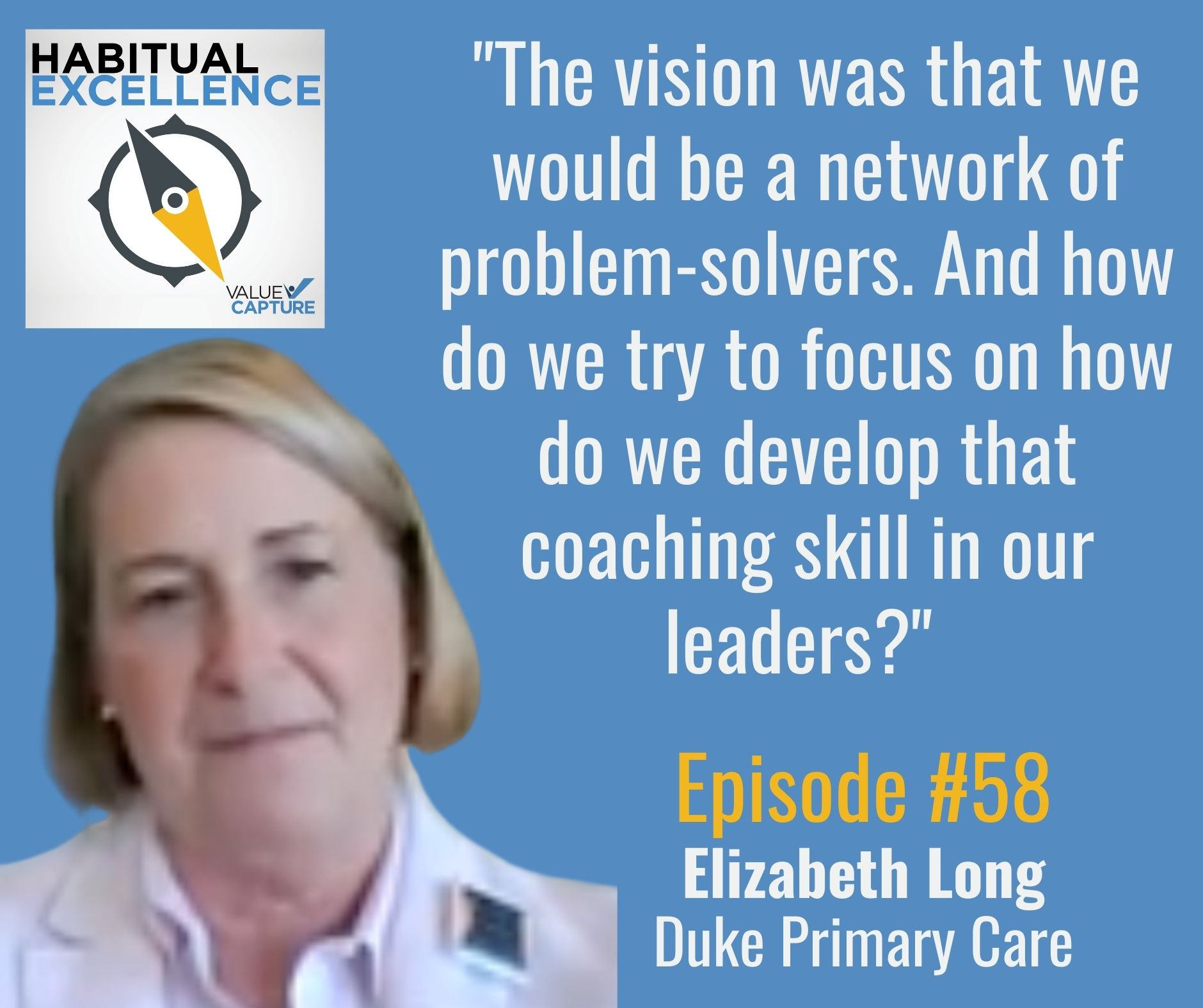
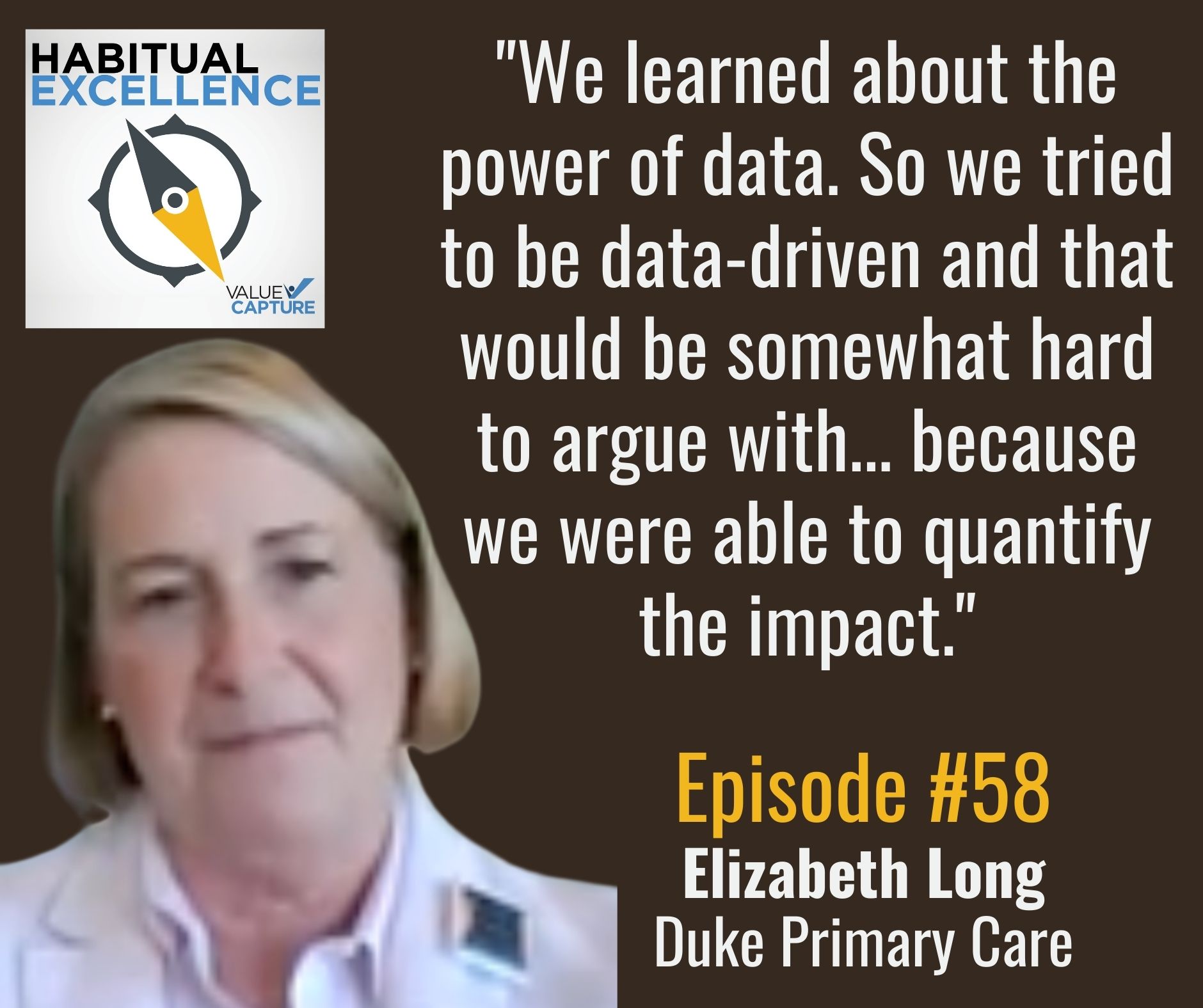
Podcast Main Page:
Click to visit the main Habitual Excellence podcast page.
Subscribe:
To make sure you don't miss an episode, be sure to subscribe today! Please rate and review the podcast.
Transcript:
Mark Graban (2s):
Welcome to Habitual Excellence presented by Value Capture, this podcast, and our firm, is all about helping you and your organization achieve Habitual Excellence, via one unifying focus, one value based structure and one performance system. In other words, it's about helping you capture dramatically more value through achieving perfect care and perfect safety for patients and staff. To learn more about Value Capture and our services visit www.valuecapturellc.com. Well, hi and welcome to Habitual Excellence. I'm Mark Graban from Value Capture and we have two guests today joining us from Duke University Health System.
Mark Graban (46s):
They are Dr. John Anderson. He is the chief medical officer for Duke Primary Care within the system. And we're joined also by Elizabeth Long, the chief operating officer. So John and Liz. Thank you both for being here. How are you?
Dr. John Anderson (1m 1s):
We are we're great. Thank you, Mark. Thank you for having us on the show.
Mark Graban (1m 7s):
Well, good. So I'd like to hear, you know, I think the audience like to hear a little bit about your backgrounds and then we'll talk about the improvement work that you're doing and how your leadership roles, how the two of you are working together. But also if you could share a little bit more about your professional backgrounds, Liz, maybe starting with you first.
Liz Long (1m 27s):
Sure. So I have the pleasure of serving as the chief operating officer of Duke Primary Care and Duke urgent care. We're a network now of about 400 providers in multiple sites around the triangle area, the Raleigh Durham area, I've devoted the better part of my professional life because physician practice management and network development. So largely focusing on strategic operations management, develop development of the network prior to that worked for the faculty practice plan for about 13 years at Stanford Medical Center.
Liz Long (2m 10s):
So have been with physician practice my entire, my entire life. So,
Mark Graban (2m 16s):
And, and mostly in academic medicine settings from, from west coast to almost all the way to the east coast. And, and John, can you share a little bit about your background and career?
Dr. John Anderson (2m 29s):
Sure. Thank you, mark. So I am a family medicine trained physician has been in North Carolina since 1983. When I finished my training became part of the Duke Health System in 95. When do primary care was created, Duke's response to the managed care movement of the nineties. And I've been in this role as chief medical officer for about 20 years as the network has grown over the years, I still have the opportunity to see patients, but have enjoy creating the culture and leading this organization over the years with a focused on quality and improvement and how we go about that work.
Dr. John Anderson (3m 22s):
So it's been a fun journey.
Mark Graban (3m 24s):
Yeah. And so it's, it'd be good to hear about that journey, the improvement journey, or however you would like to frame it there at Duke Primary Care. You, how did you get started? You know, John, you mentioned quality as a, as a key factor. I'd be curious to hear from one or both of you about some of the starting points.
Dr. John Anderson (3m 45s):
Well, it's, it's interesting. I can start off and then Liz can, we can take turns telling this story because I think it actually is a good story. And we started off long time ago. I was working with some colleagues at a neighboring institution and we were starting some of our quality work and they, they looked at me and said, you know, we, we go to this meeting every year and it's, it's a pretty fascinating meeting. I think you would like that. So they took me to my first IHI meeting back in the day when Don Berwick was leading that organization. And so over the years we had worked with the IHI, adopted their model for improvement.
Dr. John Anderson (4m 28s):
Use that approach when we were looking at, at the open access model at chronic disease care and use that for initially to get us started. And then that evolved to where it became clear that as we wanted to expand what we were doing, we, we had transforming primary care collaborative that we felt like we needed to take a little bit different approach. And that's where we got into the lane work and began more of our lean journey. Liz can talk a little bit about that and fill in some of that gap.
Liz Long (5m 13s):
It's so fun to me to think back to the early days when we started attending IHR. I remember a couple of Don Berwick plenary speeches brought me to tears and really an exciting time. And I, you know, I credit Dr. Anderson, where we really started was even before that, John, when you said we are not just a primary care network attached to an academic medical center that prefers patients into the system that we bring value and quality to our patients and set that quality vision for us.
Liz Long (5m 59s):
You also inspired the network to think of itself as a group practice rather than an affiliation of, of individual practice to this, so that it allowed us to have a mindset, a collective mindset, to agree on goals and to work collaboratively, to achieve those goals. So I don't think we can, we can miss that, that foundation that you've provided us the leadership and the access work that we did initially leaning heavily on the teachings of Mark Murray.
Liz Long (6m 40s):
I'm really dating myself. We're we achieved some really impressive results. We had really a very challenged access back in the day and wait times of six months for annual physical, that sort of thing. But we use the learning collaborative model, as John said, the, the model for improvement, and we're able to achieve some really remarkable improvements in our access. Did you want to tell your access stories now or later? So we can say, and then as John said, we started using what was, it's so funny to think back where you were using an Excel file for a disease registry, but we decided to apply for certification as a patient centered medical home.
Liz Long (7m 40s):
And what that brought us to realize was that we needed standard work and standard processes. And so John said that really got us starting down our lean journey. Additionally, at that time, we, as a system converted to the epic electronic record, which also drove home the need for standard workflows processes. And so this concept of, of standard work has been with us for about 10 years or more.
Liz Long (8m 22s):
And we realize though, after several years of being pretty solidly, entrenched in standard work for our frontline staff and providers, what we lacked was standard work for leadership. And that we didn't develop that adopted that we weren't going to be able to achieve our goals, which sort of set us on the second stage of our journey, which we're
Dr. John Anderson (8m 55s):
Still, I mean, it's, it's always, you never complete the journey.
Mark Graban (9m 1s):
So you, you mentioned improving access to care, thinking through some of the focus of why improve. I was wondering if you could explain John A. Little bit more about the quality vision, how do you define quality? How is that measured in a primary care setting, as opposed to let's say the hospital side where Duke and other organizations have a, a public pronouncement to working towards zero harm that might be more applicable on the acute inpatient care side of things. How does that differ in terms of the quality vision and primary care?
Dr. John Anderson (9m 37s):
You know, I think our focus was always grounded in the fact that we can do better. We can, we can provide better access. We can provide better blood pressure control. We can provide better well-child care. It was positionally and still is to a large degree about improvement. And how do we, you know, make fewer errors, make, get more patients to target? You know, one of the things that's been interesting to see over, certainly my career is in the, we didn't have a lot of treatments, medications, ways to get people to go with chronic illness.
Dr. John Anderson (10m 23s):
Now we have a lot more tools at our disposal. And so it's possible to get 80, 90% of our patients under control for hypertension and get 50% of our patients meeting diabetic metric. So are setting that vision that there, there is, there is always opportunity for improvement. And so then what do we need to do to generate that improvement? And that's where the standard work and focused on process. And you know, that that has led us down the path of this lean transformation in order to continue continuous improvement.
Mark Graban (11m 11s):
So you, you talked earlier about IHI, the model for improvement, a shift to focusing on management system, my impression and correct me if I'm wrong in this. But my impression of the model for improvement is that it's, it's very based on projects, teams, people doing the work. There's a lot of strengths to it, but is it fair to say that that had been project focused and then you sort of evolved past that?
Dr. John Anderson (11m 40s):
Yes, that was very much. And if you think about, you know, the work we did originally around the access that we did had some diabetes efforts underway, they were very project focused. And one thing that we lacked that, that made it challenging to sustain that work is we did not have a way to continuously improve that work. So you would go in, you'd make some changes, use a PDFA approach and achieve really as listed fairly remarkable results. But over time, unless you have a system of continuous improvement and a management system to support that, they're, they're really not sustainable.
Dr. John Anderson (12m 26s):
And that's, I think if I look back now, that's what we were lacking and what we're trying to develop and embed in the organization. Now,
Mark Graban (12m 36s):
Before diving more into the management system, I'm curious just for a little bit more of context of if either, or both of you would want to comment on what I hear you describing earlier was building teamwork and collaboration across primary care sites of looking beyond your office and looking to, to collaborate. And, and then maybe even more broadly through some of these collaboratives, can, can you speak to the power of comparing notes across sites and what that led to before, before even thinking maybe that's part of the standard work story, but, but how did that collaboration, teamwork across sites get encouraged?
Dr. John Anderson (13m 20s):
Well, I can, I can remember clearly. And it was fascinating to see when we did this work and, and it seems like a while ago, but it's hard to tell now the, when we got frontline teams engaged and making changes and improvements that their practices, they were, I mean, they're, they just lit up. It was fascinating to see that as, and they would share ideas across these practices. We'd have these learning collaboratives were, were different practices would get together and present their work. And it was the frontline.
Dr. John Anderson (14m 3s):
Primarily the frontline staff positions were engaged as well, but it was so fascinating to see the engagement of these frontline medical assistants, nurses, practice leaders just embrace this work and came up with some great stuff. I dunno, Liz can comment on that as well, but it was, it was pretty fascinating to see and very powerful.
Liz Long (14m 33s):
I think that the, we, I think it had, it also was easier to make the appeal because we learned about the power of data. So we tried to be data-driven and that would be somewhat hard to argue with. So I think that that helped some of the folks who may have been more resistant to some learning from others, because we were able to quantify the impact. And it also just took some, a little bit of leadership and setting the expectation.
Mark Graban (15m 16s):
And I imagine part of that expectation was trying to define standard work standard processes. Can you share a little bit more about that process for even deciding where to start of all the different workflows and things that are happening within the primary care setting? Where, where do you start?
Liz Long (15m 34s):
Well, we had a brilliant mind among us and Heather Marcel LRN we learned about value stream mapping. So we value stream maps, patient visits from beginning to end and included all of the indirect work and had to make conscious or deliver it decisions about scope. And what aspects were we going to focus on my recalling that correctly?
Liz Long (16m 15s):
I think that the, what rose to the top particularly hosts ethic conversion was the burden that our providers had absorbed in those in, in the, in the workflows, in the, in, during the face-to-face visit. And we didn't know if that was the most efficient, effective way to do things it's delivered the best value and, and eliminated waste.
Liz Long (16m 58s):
So that's what we focused on initially, where we're the work level, loading, the work level, loading the work
Mark Graban (17m 5s):
And that level loading come from, like looking at schedule templates during the day, and doing a better job of spacing out appointment or patient arrivals, or what else did you do to level load
Dr. John Anderson (17m 19s):
It's mainly came from his list, said doing these kind of understanding the workflow. And you could quantify who spent time doing what. And it became very clear that our providers were taking on a lot of the work that could actually be shifted to our clinical staff and would map that out and looked at where people were spending their time and what tasks they were performing. We could shift some of that work to our staff and free up free up some of the provider time. And also the other key thing was that again, in setting that standard work and reducing variability, you, you don't miss things.
Dr. John Anderson (18m 6s):
So we were able to get health maintenance, interventions done. We were get medications refilled. We, you know, you build that into standard work and, and all of a sudden you're, you're making sure things important. Things are getting done.
Liz Long (18m 23s):
It was interesting too, because we, we surveyed staff and providers before we started the work and our staff felt like their skills were under utilized and they wanted to do more. And the providers felt that the staff were probably their skills were probably under utilized as well. So, and again, it was the, the process redesign or the standard work development was a collaborative team-based effort. So there was a lot of do I edit it's interesting.
Liz Long (19m 5s):
You know, I think initially there was some resistance to standard work, but we were over time able to demonstrate the value of reduction of that variation. As Dr. Anderson mentioned, it's also been very useful subsequent to that our network went through a significant growth phase and we found that providers came to us with the expectation that we have standard work. Like how do you do things at Duke? You must do well having two things that do.
Liz Long (19m 47s):
And, and so it was very helpful to be able to, to set practices up for success from the get-go with our,
Mark Graban (20m 1s):
So maybe we can take a bit of a deeper dive now into the shift, into focusing on management system. And what, what was the inspiration or the eye-opening? Was it, was it a moment, was it just kind of over time recognizing as you described earlier, a lack of standard work for leadership is being one driver for it. What, what else led to that shift?
Liz Long (20m 28s):
I think it was, we were challenged to sustain. We were challenged to sustain also we, as I said, we're going through a significant growth phase. And so many of our leaders had not had exposure or training in lean prior to joining us. And so we, what we found was that the leadership was doing their very best, but there was really a lack of consistency in their focus and in how they prioritize work.
Liz Long (21m 15s):
And so that led us to understand and do more learning about a tiered huddle system and standard work for leadership so that we had some consistency in what people were thinking about and focusing on every day, every week, what was our, what was our escalation process so that we could help eliminate barriers and, and create a help chain. And what else am I missing?
Dr. John Anderson (21m 53s):
So the way, you know, once you establish standard work, you know, that that's not the end of the deal, you're always looking to improve and, and you could use that as a tool, but your goal is to connect. How do we make this better? How do we reach these targets? And in order to do that, I think we learned that you have to manage that it requires leadership, it requires management. And so to make sure that we were all, you know, on the same page from a management standpoint, and we had a process as lists that to escalate issues that needed to be solved, you know, and the other thing that I think we realized is that it allows you to make, once you have a management system in pro in place, you can do things actually much quicker.
Dr. John Anderson (22m 47s):
Like you don't, it, it, it streamlines the process for making decisions, solving problems, getting improvement, work, done it that works much easier when you do have a management system in place.
Mark Graban (23m 4s):
So John, you had mentioned earlier about the goal of creating a culture of quality, a culture of improvement. What were some of the continuous improvement methods or practices that that leadership would use with, with staff to help with continued PDSI?
Dr. John Anderson (23m 24s):
Well, we had, we had a various list that we did. We were able to build, I think, good data systems, so we could track. So in order, you know, you want to be able to make changes that result in improvement and, and you want to be able to those changes to demonstrate that that you're, you're making improvements. So we were able to put those systems in place, share that data with providers, we became very transparent with our data and share that across the, the network as to how we were doing and what our targets were.
Dr. John Anderson (24m 8s):
We also built some of these metrics and improvement goals into our compensation system for providers. So that certainly helped to get some attention, but I think people also took great pride in the fact that we were reaching these targets. We were, we had this focus and that it informed the care we were able to deliver. And I think, I think that that gave sense of people, a sense of pride in being part of this work
Mark Graban (24m 50s):
And Liz, how has A3 problem solving been incorporated into the daily management system for problem solving for continuous improvement?
Liz Long (25m 1s):
Well, it's the it's it's it's so I think the A3 thinking is the foundation, or it is, it is her, the, the problem, the thought process that we try to teach and reinforce, as in, for example, in morning huddle, as problems or issues are escalated, there's an, an assignment or someone will take that problem and, or the team will design a PDSA around that.
Liz Long (25m 53s):
It's really the, and, and w and it's an opportunity to reinforce the A3 thinking. So let's be clear about what problem we're trying to solve. Let's fully understand our current state, what are some countermeasures? What, what are our gaps, what are some countermeasures that we could have tried try to just solve this problem to roots? And it is, you know, the vision was that we would be a network of problem-solvers. And, and how do we try to focus on how do we develop that coaching skill in our leaders? We're still on that journey we've asked, but, but, you know, there's a learning curve.
Liz Long (26m 42s):
And so some folks are at the point where they're still, you know, learning about a three thinking and how every time you're presented with a problem, how can you apply it every time or an opportunity every time we're trying to get our folks that are a little farther along, down this path to be doing strategic <em></em> for their practice. So what's the current state of the practice health in, in totality. And, and what are the, what are the, what are the <em></em> that might come from that?
Liz Long (27m 24s):
So,
Dr. John Anderson (27m 27s):
Yeah, I think we've used it both in local problem solving. And as we think of bigger strategic network initiatives to bring that <em></em> thinking to our larger problems, and it, it gives us a nice, a useful framework to think about, okay, how do we, you know, work on access? How do we work on HCC coding and, and apply that 8 83, thinking to those big, big rocks, we're trying to move in addition to the smaller pebbles.
Mark Graban (28m 4s):
So you talked about that learning curve and on that topic, T tell us about the lean mentor program that you have. I think that's, it seems like an interesting approach for how to help people in that learning curve in their development. Can, can you share, tell us, you know, how that got started, how that works?
Dr. John Anderson (28m 25s):
So I think we came well, it, it, it was both expedient and necessary, and I expect we're not really very different from other organizations. We have a dedicated performance excellence team that houses our lean management system, but that's a small team. And for a while, we were trying to deploy them to help with this improvement event and to help get this a three off the ground a very quickly realized they don't have the capacity or the bandwidth to do that. And in fact, it has been our goal as an organization that all of our leaders, especially our regional middle management leaders, have the ability to coach and work with, with local practice leaders to develop a reach and build that capability.
Dr. John Anderson (29m 19s):
And so in order to get everybody up to speed as a, as a coach and a facilitator, we developed a program of training and mentoring so that we can basically leverage the capacity of our performance excellence team to train our leaders that can then mentor each other and spread that spread that work and capability. So it's not just relying on our, our performance excellence team, but frankly, it's a skill that, that every leader in the organization possesses that accurate
Liz Long (30m 2s):
Great description.
Mark Graban (30m 3s):
Yeah. One other element of the daily management system, I thought we could explore a little bit more deeply is the huddles you described morning huddles, tiered huddles. Can you sort of walk through an example of what that daily rhythm is at different levels?
Dr. John Anderson (30m 20s):
Well, so each practice has a, a huddle board with visual management tools on the board and practices will convene in the morning for 10, 10, 15 minutes prior to the start of the day. And it's an opportunity to both celebrate the successes. What, what are we doing well, what, what grade is going on? It's an opportunity to, to focus on operational readiness for the day, but then it's also an opportunity, okay, what are we working on? What problems are we trying to solve?
Dr. John Anderson (31m 1s):
People submit ideas or issues, problems at the practice level and get those up on the board so we can explore those. One of the challenges we had during COVID is that the huddles spent a fair amount of time. I would say the majority of their time on operational issues, just dealing with the pandemic. And so we've had to kind of migrate back towards an improvement focused, not just an operational readiness focus, and then those daily management huddles, if they're issues that come up, they get escalated through our tiered management system.
Mark Graban (31m 47s):
How many tiers are there within Duke Primary Care?
Liz Long (31m 51s):
Four, four. So in addition to the daily huddles that are with the full practice, the clinic leadership team has a daily vitals session where they have a standing agenda. They have standard work with topics that they cover any safety issues from the prior day, any staffing personnel, other sorts of what our improvement work is happening and anything to be escalated. And then, so that occurs on a daily basis.
Liz Long (32m 33s):
Any escalations can happen immediately to their regional team, but the clinic leader has a standing weekly vital report with the regional team leader. And again, report out on any safety issues, improvement, work, personnel issues, and escalations the regional teams have weekly vitals then with their AVP of operations.
Liz Long (33m 13s):
And I have weekly vitals with the AVP myself. We also have, and doctor. So Dr. Anderson has a similar parallel here system with the clinical leadership, but weekly, we have what we call tier four huddle, which is where all the teams come together. The regional teams, the ABPs also the leaders of our ancillary, what I call our ancillary support departments. So human resources, finance performance, excellence team, or pop health group.
Liz Long (33m 53s):
And there's an opportunity for recognition report out on any safety concerns or incidents, sort of a, it's a red, green, yellow report out from each regional team and the ancillary departments. And then we discuss any escalations and have report out on followup on any prior escalate escalations from prior week.
Mark Graban (34m 24s):
Before we wrap up, I wanted to close the loop back to a, I mentioned earlier of a story that you have John, about the impressive results on waiting time. Do you want to go ahead and share that?
Dr. John Anderson (34m 40s):
Well, I think a couple things come to mind, you know, w early on when we started this work as listed, we had, you know, wait times of three, four months, even longer for annual physicals. And we made one simple intervention back then we had all kinds of appointment types that were set up by a disease state and problem oriented. If you have this, you need this kind of appointment and just a myriad of appointment types.
Dr. John Anderson (35m 21s):
And we made all that go away and standardized our appointment types and immediately our, our access improved. I mean, it was, it was fairly dramatic how that happened. You know, I think now the stories I would tell are a little more challenging. You know, we're in a part of the country that's experiencing tremendous growth. The health system has grown. The demand for our services is escalating and providers are struggling, feeling burned out. And so, you know, we've, we've, we're working on access again, but the stories I would tell our patients like to come see us, they'd like to come see us in person, and they want to be able to see us when they want, when they have a need.
Dr. John Anderson (36m 23s):
And I've had a couple of experiences lately with patients that we're able to get in, not typically my patients, but patients of, of the practice. And they both ended up with very serious health issues that led themselves well to being in a primary care practice, not the ER. And we were able to get those patients into treatment. So it just, it certainly reminds me of how critical it is that, that we do provide care to patients when they want it. And, and on their terms, rather than our terms, it's such a critical way to think about it, I think.
Mark Graban (37m 9s):
Well, thanks to you, both for sharing, you know, the, the story, the transformation, like you said, it's never ending, but I'm glad that the leadership and the energy to keep that going is there and is clear to us. I think as people who are, who are hearing your story today, so our guests again today have been Dr. John Anderson, chief medical officer at Duke Primary Care, which is part of Duke University Health System, and Elizabeth Long, the chief operating officer really want to thank you both for taking the time and sharing so much with us today.
Dr. John Anderson (37m 40s):
Thank you, mark. Thank you Mark. For having us. We've enjoyed the conversation.
Mark Graban (37m 44s):
Thanks for listening to Habitual Excellence presented by Value Capture. We hope you all subscribe to the podcast and please also rate and review it in your favorite podcast, directory or app to learn more about Value Capture and how we can help your organization on this journey to Habitual Excellence, visit our website www.valuecapturellc.com.
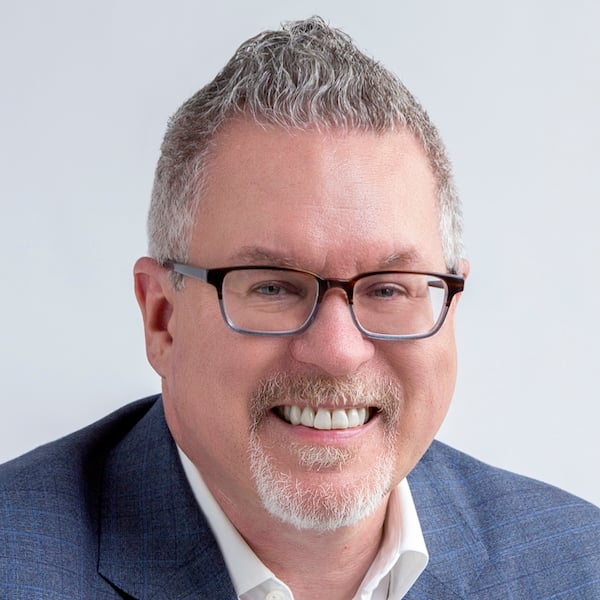
Written by Mark Graban
Mark Graban has served healthcare clients since 2005. Mark is internationally recognized as a leading author and speaker on Lean healthcare. His latest book is "The Mistakes That Make Us: Cultivating a Culture of Learning and Innovation."

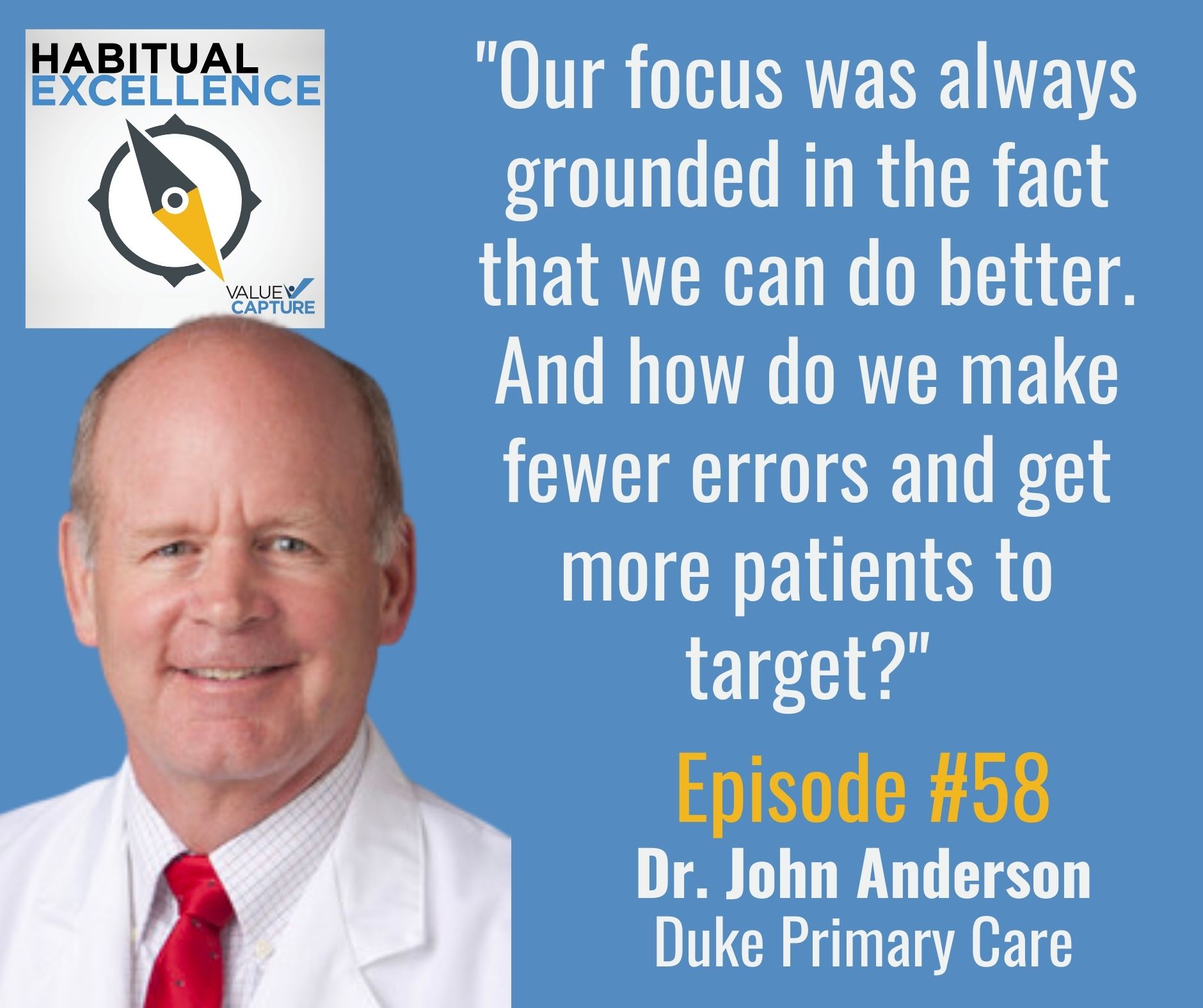
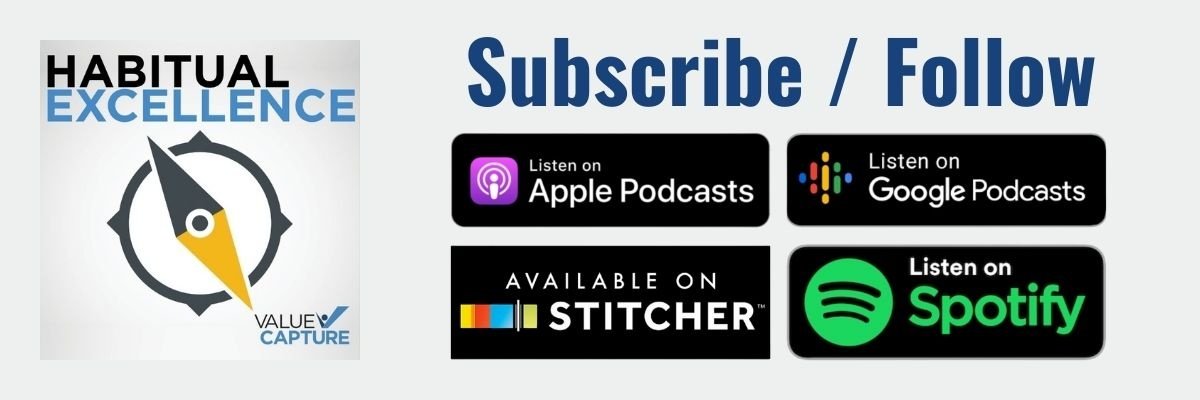
Submit a comment